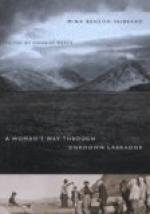A swift change followed these few words in their own familiar tongue. There was eager talking together, the screams of terror were changed to laughter, and four of the older women ran down to the landing to welcome us. We were greeted with much handshaking, and their number was gradually swelled from the camp on the hill. They displayed not the least sign of shyness or embarrassment, being altogether at their ease. Their clothing was of a quite civilised fashion, the dresses being of woollen goods Of various colours made with plain blouse and skirt, while on their feet they wore moccasins of dressed deerskin. The jet black hair was parted from forehead to neck, and brought round on either side, where it was wound into a little hard roll in front of the ear and bound about with pieces of plain cloth or a pretty beaded band. Each head was adorned with a tuque made from black and red broadcloth, with beaded or braided band around the head. Both the manner of wearing the hair and the tuque were exceedingly picturesque and becoming, and the types were various as those to be found in other communities, ranging from the sweet and even beautiful face to the grossly animal like. They were not scrupulously clean, but were not dirtier than hundreds of thousands to be found well within the borders of civilisation, and all, even the little children, wore the crucifix.
Their men had gone down to Davis Inlet, on the east coast, to trade for winter supplies. They had been away five days and were expected to return soon, the outward trip being made in three or four days while the return requires five. The camp was now eagerly awaiting the arrival of the tea, sugar, and tobacco, the new gowns, the gay shawls and the trinkets which make the return from the post the great event of the year.
As their speech indicated, these people were found to belong to the Montagnais tribe, which is a branch of the Cree Nation, and is tributary to the posts along the St. Lawrence. There after the winter’s hunt they gather in hundreds at Mingan and Seven Islands, and it is then they receive from the Roman Catholic missionaries instruction in the Christian faith. This camp, the only one of the tribe to do so, had for some years traded at Davis Inlet, on the northeast coast. We could gather little from the women about the route to Davis Inlet further than that it is a difficult one, and for this reason they do not accompany the hunters on the yearly journey there.
The “Mush-a-wau e-u-its” (Barren Grounds people), the Nascaupee Indians, whom Mr. Hubbard had been so eager to visit, and who also are a branch of the Cree Nation, they informed us, have their hunting grounds farther down the river.
“You will sleep twice before coming to their camp,” they said.
We were assured of a friendly reception there, for the two camps are friendly and sometimes visit each other; but they could tell us little about the river, because in making the journey between the two camps, they use a portage route through lakes to the east of the river. The journey to the George River post at Ungava they thought would take two months.




